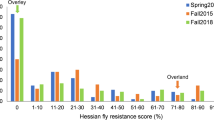Abstract.
Hessian fly is one of the world's most destructive insect pests of wheat Triticum aestivum L. We have used the combination of near-isogenic lines (NIL) and random amplified polymorphic DNA (RAPD) analysis to screen up to 2,000 primers to identify DNA markers that are linked to gene H6 that confers resistance to biotype B of the insect. This screen produced six primers that show polymorphic fragments associated with resistance by H6. We have screened 440 F2 individuals from a cross of the susceptible cultivar Newton and a NIL that contains H6 to verify the linkage between these markers and the resistance gene. A high-resolution genetic map was constructed based on recombination frequency. Two of the markers were tightly linked to the gene with no recombination observed, three were within 2.0 cM, and one was 11 cM from the gene. Three of the six markers were successfully converted to sequence tagged site (STS) markers. Both RAPD and STS primers were used to screen for the presence or absence of the resistance gene in wheat varieties. The identification of markers and construction of the genetic high resolution map provide the first steps toward localization of this resistance gene.
Similar content being viewed by others
Author information
Authors and Affiliations
Additional information
Electronic Publication
Rights and permissions
About this article
Cite this article
Dweikat, .I., Zhang, .W. & Ohm, .H. Development of STS markers linked to Hessian fly resistance gene H6 in wheat. Theor Appl Genet 105, 766–770 (2002). https://doi.org/10.1007/s00122-002-0946-9
Received:
Accepted:
Issue Date:
DOI: https://doi.org/10.1007/s00122-002-0946-9




